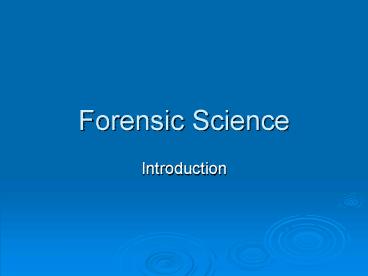Forensic Science - PowerPoint PPT Presentation
1 / 18
Title:
Forensic Science
Description:
Forensic Science is a young' science. Its' successful implementation by criminal ... Corroborate the victim's testimony. Lead to a confession from a suspect ... – PowerPoint PPT presentation
Number of Views:151
Avg rating:3.0/5.0
Title: Forensic Science
1
Forensic Science
- Introduction
2
Key Concepts
- Forensic Science
- Physical Evidence
- Class Characteristic
- Individual Characteristic
3
Forensic Science
- Forensic Science is a young science.
- Its successful implementation by criminal
investigators has only been done within the past
100 years.
4
Forensic Science
- Forensic Science is unique because it encompasses
all three scientific disciplines biology,
chemistry, and physics.
5
Forensic Science
- One definition of forensic science is the
application of biochemical and other scientific
techniques to investigate crime.
6
Forensic Science Careers
- Becoming a Forensic Scientist requires an
education. - At minimum, you need a bachelors degree to work
in the field. - There are many different fields that are used in
forensic science.
7
Forensic Science
- After a crime has occurred criminal investigators
may use scientific techniques or forensic science
experts to help them identify or interpret
physical evidence from the crime scene.
8
Forensic Science
- Physical evidence from a crime scene comes in
many different forms. - Fingerprints
- Hair
- Blood
- Saliva
- Bullet casings, etc.
9
Why process physical evidence?
- Finding and interpreting physical evidence can
- Prove that a crime has been committed
- Establish the identity of the suspects.
- Exonerate the innocent
- Corroborate the victims testimony
- Lead to a confession from a suspect
- Be more reliable than eyewitness evidence.
- Be expected by judges and juries.
10
Physical Evidence
- Therefore, physical evidence is important to the
Forensic Scientist as it is used to interpret and
draw important conclusions about the events
within a criminal case.
11
Physical Evidence
- In general all forms of evidence have class or
individual characteristics.
12
Physical Evidence
- Class characteristics are not unique to a
particular object but place the particular bit of
evidence into a group of objects.
13
Physical Evidence
- Individual characteristics narrow down the
evidence to one person or a very small group of
individuals.
14
Physical Evidence
- The type of handgun with which the victim is shot
is a class characteristic. - For example, if the bullet came from a .38
caliber handgun, every .38 caliber handgun on the
planet is the possible murder weapon. - However, finding a suspects fingerprint (an
individual characteristic) on a .38 caliber
handgun points the investigation in the direction
of a single person.
15
Physical Evidence
- Alternatively, blood recovered from a crime scene
that tests show is type B (a class
characteristic) could come from any of the tens
of millions of people who share this blood type. - If the suspect has type B blood, he or she
remains a suspect. - From there, DNA (an individual characteristic)
from the suspect and DNA from the blood evidence
are tested to determine conclusively whether they
match. - If, however, the suspects blood is type A, he or
she is excluded.
16
Physical Evidence
- A single piece of class evidence rarely can be
used to convict someone, but it can be and often
is used to exonerate someone. - However, when multiple types of class evidence
associate one suspect with the crime and crime
scene, the weight of that evidence can make for a
stronger case.
17
Physical Evidence
- The most individualizing types of evidence are
fingerprints and DNA, because they are completely
unique. - Impression evidence such as marks left on a fired
bullet, shoeprints, tire tracks, and tool marks
may be unique and therefore have individual
characteristics.
18
Physical Evidence
- The overriding principle in analyzing individual
characteristics is that no two things are exactly
alike. - No two guns mark a bullet the same way.
- No two pieces of glass fracture in the same
manner. - No two pairs of shoes or sets of car tires wear
in exactly the same way.































